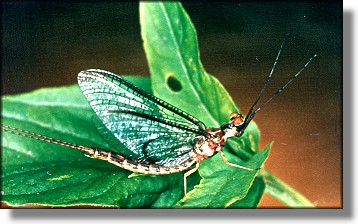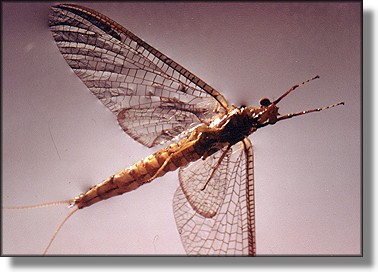Waiting for the Hexagenia limbata
event at 3 AM has to remind one of the old high school snipe
hunting game. You wait and wait, with that big burlap bag
for those wily snipe to run into it. At 4 AM the Hex wins
again and along with the snipe hunters you call it a
night and go home. In general snipe hunters learn the first time.
Hex fishers never do. Snipe are more common on some summer
nights than the hex hatch.

Hexagenia limbata hatches in the mid-west and
other isolated parts from mid-June to mid-July. This monster is a
burrower that makes a five inch U shaped burrow in the silt and
finally emerges at night with a sound that reminds one of a muted
snook munching on prey. An ugly pop that a person never forgets.
Once heard it addicts the fisher for a life time, and causes day
dreams of flies the size of bats and rise forms that remind one of a
wash tub full of concrete dropped into the water from a height of
five feet or so. These are fish with names like Flipper and Willy.
Prudent fishers rope themselves to big trees before casting to them.
These flies are members of the order Ephemeroptera
which roughly means short-living insect with wings, a two-inch
plus mayfly, the spinner flight of which sound like the hum of high
voltage electric lines. Casting during the spinner fall reminds one
of smacking pigeons with a fly rod in central park. Cast-smack,
smack, smack, cast-smack, smack, smack.
Dear Sir: I damaged my new Gatti fly rod hitting those big flies
during a hex spinner fall. I will write a letter of support in your
behalf. It should fly.

This mayfly is a burrower and in polluted environments the lack
of oxygen precludes their existence. Put-In-Bay now has densities
of 300-500 nymphs per square meter. In localized areas,
concentrations of 1000 per square meter is in the literature.
Now with the increasing emphasis on clean water, Lake Erie
has flights that have been spotted on WJET-TV's Doppler
radar---some 10 miles long. I have seen birds in Port Clinton,
Ohio that were too stuffed to fly. We had brownouts due to
swarms of flies that settled on electrical equipment and conducted
electricity across insulation. The fly sometimes mistakes asphalt
for streams and stacks up on the roadway making travel questionable.
Densities of 950 in a hula hoop have been documented. These
swarms with the help of cleaner water and a little wind are helping
to re-populate our inland rivers and lakes. I don't fish this fly in
lakes, but those who do fish lakes should be prepared for them.
I have heard them referred to as: The Caddis Hatch, Michigan
caddis, shadfly, fishfly, Canadian soldier, duns, junebug, giant
Michigan mayfly, great olive-winged drake, and so on.

In the rivers I've fished, the hatch and or the spinner fall happens
usually between 10 PM and 4 AM. This can be a 20-30 minute
event. Cast fast. The nymph spends about a year and a half in the
silt. It departs to the surface, fast and agile, wiggling, sometimes
taking two minutes to get airborne. The spinner fall happens about
72 hours after the emergence, most of the time the females will
lay their 8000 egg load over riffles. Warm nights with no wind
seem to produce the best fishing events. The first of the hatch or
spinner fall can be best, later in the event the fish react sporadically
and are more selective. A moon-lit night is too tough for me. Dark
is best. If large struggling emergers don't work then quickly switch
to spinners.
This hatch happens in marl-laden or silty areas. Lake hatches
extend longer than those in rivers. The hatch moves from warmer
to colder water, usually up stream, but not always.
The fly is a yellowish olive to golden olive fly in a size 6-8. Most
of the time I see it imitated by flies in the 4-6 range, hummingbird
ties that are fished on 6 foot leaders and 2x tippets. A seven to an
eight wt rod I would think.
 Pusher type flies (George Harvey) or monsters with elk or calf-hair
wings, palmered with hackle big enough to float a Foster's Lager
can are the way to go. The nymph is generally tied as a wiggle nymph
with pheasant filo plumes along the sides. The emergers are tied
with more marabou than a stork ever carried. More is better.
Pusher type flies (George Harvey) or monsters with elk or calf-hair
wings, palmered with hackle big enough to float a Foster's Lager
can are the way to go. The nymph is generally tied as a wiggle nymph
with pheasant filo plumes along the sides. The emergers are tied
with more marabou than a stork ever carried. More is better.
I used to scout the area during the day and measure the distances I
could cast before I would end up in a bush, sweeper, or log jam. I
would put a piece of surgical tape on the line to warn me. That piece
of tape saved me night after night.
Fishing this hatch is never a solitary event. The good areas have
had maximum coverage for the last 30 years and before. Shoulder
to shoulder, night after night. Don't expect anything any different.
A guided float trip below areas where the wading fishermen
congregate might be worth the price. On my river, the Au Sable,
the stretch from Wakely Bridge to Mio Pond was king. The best
area was from Conner's Flats to the whirlpool access west of Mio.
Fish the nymph with a lot of movement, and the dry, across, dead
drift and then back up with short twitches. Fishing the individual
big fish is the way to go. Dropping the fly a foot above an active
feeder is the class act. I hear some really use surplus Russian night
vision goggles. Leave your glasses at Gate's Lodge, but bring your
hearing aid. After nightfall hearing is king.
The hex is not the only big fly that happens at this time of year. I used
to fish the Wakely Bridge water every evening all season long. I will
never forget the Stone fly I saw in a Mason jar full of alcohol, as
large as my little finger and as long as my first finger. I had heard
rumors of the big flies there but when I saw it I was amazed. There
are some big flies in that river.
Rusty's, Gates Au Sable Lodge sign said it all, "Almost better than
sex, we got hex." Old rupe
P.S. Clive Schaupmeyer even reported the hatch in Alberta,
Canada. I doubt if Skip Madsen and his wife Gail still remember me,
but they always fished the hatch as well as it was ever fished in Grayling,
Michigan. Fish the hatch where there are big trout and hang on.
Old Rupe

For the tying method on the Robert's Drake, click
here.
Special credits: All Photos by James Birkholm.
|





 Pusher type flies (George Harvey) or monsters with elk or calf-hair
wings, palmered with hackle big enough to float a Foster's Lager
can are the way to go. The nymph is generally tied as a wiggle nymph
with pheasant filo plumes along the sides. The emergers are tied
with more marabou than a stork ever carried. More is better.
Pusher type flies (George Harvey) or monsters with elk or calf-hair
wings, palmered with hackle big enough to float a Foster's Lager
can are the way to go. The nymph is generally tied as a wiggle nymph
with pheasant filo plumes along the sides. The emergers are tied
with more marabou than a stork ever carried. More is better.